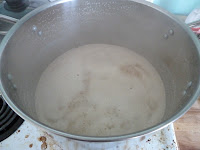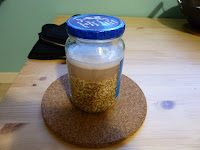 |
| Not much to it, really. |
 |
| Sanitation is very important. |
This was a fairly simple beer, just some extra-light DME, a little crystal malt, the buckwheat I roasted yesterday, Amarillo hops left from my porter and a packet of dry yeast. The day was never-the-less not without its complications, which started when I realized I didn't have any cheese cloth to strain the water from my steeping grains and had to go out to buy some on the sheets of ice Edmonton is currently experimenting with as replacement sidewalks. Fortunately, I've been trained to fall without getting hurt.
First off, I needed to crush my steeping grains, the buckwheat I roasted yesterday (which weighs in at a little less after the roasting) and 50g of extra-dark crystal malt.


Although I'm making a larger batch than last time, you can see I'm steeping a lot less grains, since I'm trying for a lighter colour:
The colour I got from this steep wasn't as red as I would have liked - you'll see at the end it's more of a cuivrée than an amber - but I think that's down to my choice of grains. Oh, well. The steeping water is slightly cooler to start with this time, and I wrapped a towel around the cooler in the hopes that I would have a more consistent temperature over time. It seemed to work.
Estimating that I got about four liters back from my ~4.5 liter steep (I probably got less, the buckwheat took up a lot) and that I would get something like one liter of boil-off in sixty minutes (based on my last batch), I topped up with about a liter and a half (okay, actually that number was as arbitrary as these parentheticals are becoming) for the boil and added my bittering hops.
 |
I only used three grams, since this is meant to be a light
"session" beer. |
I boiled for about 45 minutes before adding the extract; for some reason I wanted to add it before the aroma hops, which went in with ten minutes left (out of 60 minutes total boiling time).
 |
| Three grams this time as well. |
Finally, while my wort was chilling in the sink like last time, I rehydrated my yeast. Package directions call for rehydrating in water between 80-92 degrees Fahrenheit, and then adding a little wort at a time to bring the yeast gradually down to the wort's temperature (about 72 degrees).
Once again I underestimated my boil-off and/or over-estimated the yield from my steep; I was more than a liter short of where I expected to be. I decided to top it right up to six liters - it's meant to be a session beer anyway, only three or four percent alcohol.
My original gravity (OG) reading doesn't line up with that at all, though! It's something like 1.065, and temperature correction doesn't make much difference... According to every brewing calculation I can find, this is way off, and my OG shouldn't be much over 1.040. I'm guessing it's starches from the buckwheat, mostly, which is probably going to mean cloudy beer but isn't going to increase my ABV at all - it should still come out around 4%, maybe 4.5% if the yeast really goes to town (I've heard Nottingham gives high attenuations).

All's well that ends well, of course so... In about a month, when this is ready, I'll let you know if it's well. There's still one last complication with this batch, too... I've decided it will be my first in glass bottles. We'll see how that works out!























